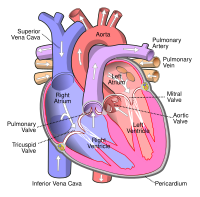
Photo from wikipedia
Traditional percutaneous device closure of perimembranous ventricular septal defects (PmVSDs) is a minimally invasive technique, but can result in high radiation exposure and potential arterial complications. The feasibility of another… Click to show full abstract
Traditional percutaneous device closure of perimembranous ventricular septal defects (PmVSDs) is a minimally invasive technique, but can result in high radiation exposure and potential arterial complications. The feasibility of another alternative surgical repair technique for closure of VSDs by percardiac device has been proven. However, the disadvantages of surgical trauma and incision in the inferior sternum cannot avoid. In an effort to avoid radiation exposure, arterial access, surgical incision and complications, we established a novel technique for transcatheter VSD closure via the femoral vein approach under the guidance of transesophageal echocardiography (TEE) without fluoroscopy. And the feasibility and safety of this new strategy have been assessed. From January 2015 to June 2019, a total of 48 PmVSD patients (mean age, 7.5±2.4 years [range, 4.3– 12.0 years]; mean body weight 24.6±6.8 kg [range, 16.5–38.5 kg]; VSD diameter, 4.3±0.6 mm [range, 3.2–5.0 mm]) underwent attempted transcatheter closure via the femoral vein approach under the guidance of TEE without fluoroscopy. The transcatheter occlusion procedure under TEE guidance was successful in 46 (95.8%) patients. Surgery was necessary in 2 (4.2%) patients. The mean procedural duration, post-operative mechanical ventilation duration, intensive care unit (ICU) residence, and in-hospital durations were 27.2±7.4 min (range, 12.0–42.0 min), 63.2±5.3 min (range, 56.0–78.0 min), 2.1±0.1 h (mean, 2.0–2.4 h), and 2.7±0.3 d (range, 2.5–3.0 d), respectively. One patient had immediate post-operative trivial residual shunt and four patients had immediate incomplete right bundle branch block (IRBBB) after operation; the new IRBBB in 2 cases were noted in the first postoperative month. No residual shunt was noted at 3 months after the procedure, and no intervention related complications were detected at 1–36 months follow-up. Echocardiography-guided percutaneous device closure of PmVSDs solely by femoral vein approach is effective and safe, avoids radiation exposure, potential arterial complications and a surgical incision. Procedure of percutaneous closure PmVSD Type of funding source: Foundation. Main funding source(s): The Scientific Research Foundation for the Returned Overseas Chinese Scholars, State Education Ministry.
Journal Title: European Heart Journal
Year Published: 2020
Link to full text (if available)
Share on Social Media: Sign Up to like & get
recommendations!